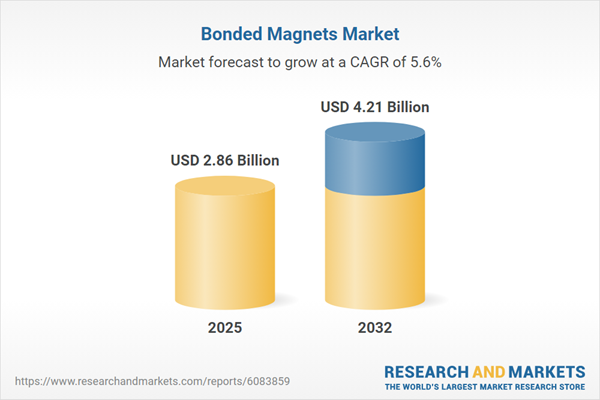Speak directly to the analyst to clarify any post sales queries you may have.
The bonded magnets market is reshaping global manufacturing by delivering versatile, high-performance solutions across automotive, electronics, healthcare, and renewable energy industries. As design complexity and efficiency demands intensify, bonded magnets present a strategic option for innovation-driven enterprises.
Market Snapshot: Bonded Magnets Market Size and Outlook
The Bonded Magnets Market grew from USD 2.71 billion in 2024 to USD 2.86 billion in 2025. It is expected to continue growing at a CAGR of 5.63%, reaching USD 4.21 billion by 2032. This growth reflects industry-wide migration toward lightweight magnetic materials that combine cost-efficiency, performance, and scalability. Sustained investment in advanced bonded magnets enables industries to address complex engineering challenges and regulatory requirements across key regions.
Scope & Segmentation
- Product Types: Aluminium, Nickel & Cobalt; Ferrite; Neodymium Iron Boron; Rare Earth Cobalt; Samarium Cobalt; Samarium Iron Nitride.
- Process Methods: Calendaring; Compression Bonding; Extrusion; Injection Molding.
- Applications: Automotive Components; Electronics; Home Appliances; Medical Devices; Renewable Energy Systems.
- Distribution Channels: Offline (Direct Sales, Distributors); Online Retail.
- Regions Covered: Americas (United States, Canada, Mexico, Brazil, Argentina, Chile, Colombia, Peru); Europe (United Kingdom, Germany, France, Russia, Italy, Spain, Netherlands, Sweden, Poland, Switzerland); Middle East (United Arab Emirates, Saudi Arabia, Qatar, Turkey, Israel); Africa (South Africa, Nigeria, Egypt, Kenya); Asia-Pacific (China, India, Japan, Australia, South Korea, Indonesia, Thailand, Malaysia, Singapore, Taiwan).
- Key Companies: AA International, Allstar Magnetics, Alpha Magnet, Arnold Magnetic Technologies, Bunting-DuBois, Daido Electronics, Dailymag, Dexter Magnetic Technologies, Dura Magnetics, Eneflux Armtek Magnetics, Evitron, Faizeal, GMB Deutsche Magnetwerke, Hangzhou Tengye Magnetic Materials, HGT Advanced Magnets, Hunan AEMagnets, Magnaworks Technology, Michibay Magnetics, MMC Magnetics, National Magnetics Group, NICHIA, Sagami Chemical Metal, SDM Magnetics, Shin-Etsu Chemical, TDK Corporation, The Electrodyne Company, Thomas and Skinner, Viona Magnetics.
Key Takeaways for Senior Decision-Makers
- Bonded magnet technologies empower manufacturers to design intricate, lightweight components, reducing overall production costs and broadening application potential.
- Technological progress in polymer binders and powder treatment enhances consistency and supports precision-demanding uses in sectors like aerospace and medical devices.
- Growing focus on sustainable production has spurred the adoption of ecofriendly binders and recycling schemes, aligning industry practices with modern regulatory frameworks.
- Automotive electrification, device miniaturization, and energy efficiency standards are primary growth drivers shaping market priorities across global regions.
- Joint ventures, industry collaborations, and co-development initiatives are accelerating market entry and innovation, especially in high-growth, region-specific clusters.
- Companies leveraging digitalization in production benefit from improved quality control, predictive maintenance, and operational reliability, strengthening long-term competitiveness.
Tariff Impact and Supply Chain Strategies
In 2025, newly introduced United States tariffs on imported bonded magnet components reshaped sourcing strategies. Manufacturers are diversifying suppliers, expanding onshore operations, and refining formulations to reduce reliance on high-tariff inputs. Companies are also adapting through long-term procurement agreements and regional production shifts to sustain agility in a changing regulatory environment. These actions underscore how trade regulation and material innovation are interdependent factors in current supply chain management.
Research Methodology & Data Sources
This report integrates primary and secondary research streams. Data collection involved a literature review of scientific and industry sources, regulatory filings, trade statistics, and company financials. In-depth interviews and facility surveys supplied nuanced insights into strategic priorities and operating metrics. Findings were rigorously validated through triangulation, expert peer review, and advanced scenario modeling to ensure reliability and actionable clarity.
Why This Report Matters
- Supports strategic decision-making by highlighting technology shifts, regional growth dynamics, and actionable supply chain strategies for bonded magnet adoption.
- Identifies key opportunities in high-growth markets such as electric mobility and renewable energy, facilitating competitive positioning.
- Enables leaders to benchmark performance, risks, and innovation potential against global industry standards, guiding investment and operational planning.
Conclusion
The bonded magnets market is evolving through technical innovation, regional adaptation, and collaborative development. Stakeholders equipped with robust intelligence from this research can drive resilience and seize emerging opportunities across diverse end-use sectors.
Table of Contents
3. Executive Summary
4. Market Overview
7. Cumulative Impact of Artificial Intelligence 2025
Companies Mentioned
The companies profiled in this Bonded Magnets market report include:- AA International, Inc.
- Allstar Magnetics, LLC
- Alpha Magnet LLC
- Arnold Magnetic Technologies
- Bunting-DuBois
- Daido Electronics Co.,Ltd.
- Dailymag
- Dexter Magnetic Technologies, Inc.
- Dura Magnetics, Inc.
- Eneflux Armtek Magnetics, Inc.
- Evitron Sp. z o.o.
- Faizeal Inc.
- GMB Deutsche Magnetwerke GmbH
- Hangzhou Tengye Magnetic Materials Co., Ltd.
- HGT Advanced Magnets Co., Ltd.
- Hunan AEMagnets Limited
- Magnaworks Technology Inc.
- Michibay Magnetics LLC
- MMC Magnetics Corp
- National Magnetics Group, Inc.
- NICHIA CORPORATION
- Sagami Chemical Metal Co., Ltd.
- SDM Magnetics Co., Ltd.
- Shin-Etsu Chemical Co., Ltd.
- TDK Corporation
- The Electrodyne Company, Inc.
- Thomas and Skinner Inc.
- Viona Magnetics
Table Information
| Report Attribute | Details |
|---|---|
| No. of Pages | 196 |
| Published | November 2025 |
| Forecast Period | 2025 - 2032 |
| Estimated Market Value ( USD | $ 2.86 Billion |
| Forecasted Market Value ( USD | $ 4.21 Billion |
| Compound Annual Growth Rate | 5.6% |
| Regions Covered | Global |
| No. of Companies Mentioned | 29 |








